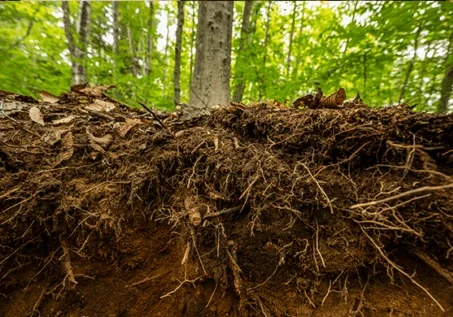Forest Soils: The Hidden Secret to Thriving Woodlands [Expert Guide]
Forest soils are living, breathing ecosystems that serve as the foundations of thriving woodlands worldwide. A handful of healthy forest soil contains as many individual organisms as Earth's entire human population. This remarkable biodiversity beneath our feet isn't just the sort of thing I love—it ranks third in importance after air and water for life on land.
The complex organic layers of temperate deciduous forest soils reveal an intricate network that supports all woodland life. More than 35% of Europe's forest soils face degradation, which shows why we need environmentally responsible forestry practises now. These soils play vital roles by supporting tree growth, storing and filtering water, cycling nutrients, and storing more than half of all carbon in U.S. forests.
Let's take a closer look at forest soils—nature's hidden heroes of woodland ecosystems. You'll learn what keeps them healthy and how they support biodiversity both above and below ground. The practical steps to protect and boost these soils matter most. Anyone who manages woodlands or appreciates forest ecosystems should become skilled at understanding these underground networks. This knowledge helps ensure our forests stay resilient for future generations.
The Role of Forest Soils in Ecosystem Health
Forest soils do more than just support trees - they're the backbone of woodland ecosystems. These living systems control many key processes that keep ecosystems healthy and strong.
You'll find forest soils work like natural sponges in managing water. They soak up water with impressive efficiency, storing up to 6 times more than open areas. This unique feature stops surface runoff, cuts down erosion risks, and releases water slowly into streams and groundwater. So forests naturally philtre and provide us with clean drinking water.
The soil also works as a nutrient powerhouse. It makes the exchange of nutrients easier between soil, plants, and the atmosphere. This natural cycle keeps forests productive without needing the extra help that farmland typically requires.
The role of forest soils as carbon storage banks might be their most valuable feature. These soils hold about one-fifth of all land-based carbon. Boreal forest soils are particularly impressive - they store 80-90% of their total forest carbon underground. Temperate forests often pack more carbon in their soil than in the trees and plants above ground.
Forest soils create tough ecosystems through these functions. They support diverse wildlife while offering vital environmental benefits to human communities.
Biodiversity Beneath the Forest Floor
Life beneath the forest floor buzzes with activity that matches any ecosystem on Earth. This underground world teems with countless organisms. From tiny bacteria to visible insects, they all work together in perfect harmony.
The soil's microbial community features five main bacterial phyla: Acidobacteria, Actinobacteria, Proteobacteria, Bacteroidetes, and Firmicutes. Fungi thrive abundantly in forest soils. The ratio of fungal-to-bacterial biomass ranges from 5:1 to 10:1 in deciduous forests and reaches an impressive 100:1 to 1000:1 in conifer forests.
The sort of thing I love about this hidden world is the mycorrhizal network—known as the "wood wide web"—where fungal threads link trees together. These amazing networks help trees share resources and information. Trees use these connections to transfer carbon, water, nitrogen, phosphorus, and even send warning signals about threats from pests or pathogens.
The numbers for soil fauna will blow your mind. Around 10^19 soil arthropods exist on Earth, and soil mites and springtails make up about 95% of them. Termites dominate the total soil arthropod biomass at 40%, while ants contribute just 10%.
Different forest types show distinct biodiversity patterns. Deciduous forests pack more total soil fauna biomass (8.0 g/g soil) than coniferous forests (2.4 g/g soil). These numbers show how tree species shape their underground communities.
How to Maintain Healthy Forest Soils
A careful approach to forest soil management helps protect biodiversity and minimises disruption. Research shows that forest soils store about 75% of UK forests' carbon, making them crucial in fighting climate change.
Healthy soil needs protection from compaction. Equipment should stay on 20-year old roads and trails, and workers should use smaller machines with low PSI tyres whenever possible. Woody debris can help distribute weight better on sensitive soil sites.
Forest health depends heavily on soil organic matter. After timber harvesting, at least 10-15 tonnes of large woody material per acre (>3 inches diameter) should remain. Western conifer forests need different amounts - from 5-13 tonnes/acre in ponderosa pine areas to 16-33 tonnes/acre where western hemlock grows.
The forest understory plays a vital role. It prevents soil erosion and creates wildlife habitats while supporting nutrient cycles. The ground cover under forest canopy actually protects against erosion better than the trees above it.
Tree diversity makes a big difference. Studies reveal that diverse tree populations boost soil carbon storage by 30-32% and nitrogen levels by 42-50% over decades. Adding different tree species, especially broadleaf trees among conifers, creates stronger and healthier forest soils.
Conclusion
Forest soils stand as one of nature's most remarkable yet overlooked ecosystems. In this piece, we've found how these living systems work as woodland health's foundation. They act as natural water philtres, nutrient cycling powerhouses, and carbon sinks. These soils host biodiversity that matches any ecosystem above ground, which might surprise many.
The complex "wood wide web" of mycorrhizal networks under our feet shows nature's brilliant communication system. Trees share resources and information through fungal connections. This underground cooperative effort shows why we should see forest soils as living communities rather than just dirt.
These vital resources need thoughtful protection. Healthy forest ecosystems thrive when we minimise soil compaction, keep adequate woody debris, preserve understory vegetation, and encourage tree diversity. These actions matter even more since forest soils store about 75% of UK forests' carbon.
Without doubt, our woodlands' future depends on how we care for the ground beneath them. Everyone can help preserve soil biodiversity and function, whether they manage large forest tracts or small woodland gardens. It's worth mentioning that thriving forests start with healthy soils - the true hidden heroes that work quietly beneath the forest floor.


